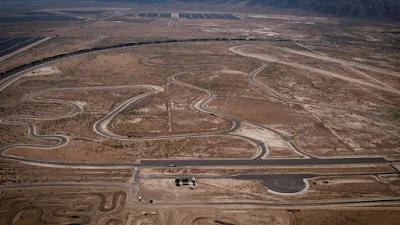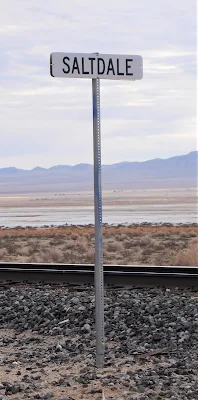Back in February, I wrote a piece concerning a little town that no longer exists.
The name of this place was Saltdale. This town once existed in the Mojave Desert, on the edges of the now dry Koehn Lake. It was one of those stories that made me ponder as I walked across the mucky semi-wet salt beds checking out this abandoned house and that sinking structure in the salt.
Often I travel with my beautiful wife, Laureen, or perhaps with my buddy Paul, on these adventures. But many times I travel alone, this was one of those times.
As I stood alone, looking out across the vast stretches of land that lay before me, I could almost hear machinery running, vehicles driving here and there, people talking, and children playing.
It was surreal.
Recently, I received an email from a wonderful young lady by the name of Becky Gallen who had read the piece and enjoyed it.
That piqued my interest right away – she liked my story. A writer’s dream – someone who enjoyed what I wrote.
Turns out that another small town, that still has a few residents, is just six miles to the west of the Saltdale I wrote about. It was once a thriving town of families, businesses, and the like – by the name of Cantil.
Cantil is an unincorporated community located in Kern County in the Fremont Valley.
Becky informed me that her 95-year-old mother still lived in Cantil – in the house that she and her husband, Bill, shared.
Like many small towns located across the vast Mojave Desert, there doesn’t appear to be much to see. But when a person looks closer, there is.
What I learned after briefly communicating with Becky reinforced what I had assumed about these small towns: some gone with the wind and some barely hanging on, were once vibrant communities with fascinating citizens.
Becky had shown my article about Saltdale to her mother. Becky’s mother told her that more than once over the years someone would drive out into the wet and mucky surface on Koehn Lake and get their vehicles stuck, hopelessly stuck.
.JPG) |
| Koehn Lake |
I knew the feeling, since I had nearly lost a boot in the muck on my visit, and I don’t quite weigh as much as a pick-up truck – thank you Nutri-System.
The two communities of Saltdale and Cantil were linked with all the salt production occurring in and near Koehn Lake.
Of course, when the mining panned out so did Saltdale. Cantil is still viable, though not as thriving as it had once been.
Cantil was founded as a railroad station for the Nevada and California Railroad Company back in either 1908 or 1909. More tracks were needed from Owens Lake to Mojave to deliver minerals and other goods being mined or produced in the Owens Valley for consumers to the ever-growing town of Los Angeles.
Since it was the custom for railroads to follow the alphabet when naming stations, it was the letter C’s turn.
“Let’s call it Cansas,” one railroader suggested.
“No,” replied another worker. “How about Cornswabble?”
The lead railroader shook his head. “We’ll call it Cantil. After all the red cliffs we see in the nearby mountains which remind me of the time I spent in Spain.”
“Show off,” a railroad hobo stated from beneath a cattle car.
So, Cantil was off and running.
When I visited Saltdale, I was moved to write about it - nothing there but a large dry lake with lots of muck to sink into among the dilapidated buildings and other structures.
At first, I thought there wasn’t a story to be written, but I was wrong. People survived, thrived, and enjoyed living here.
As they did in the neighboring town of Cantil.
In fact, Cantil and many other small communities played a major role in providing water and other goods for travelers across the Mojave Desert.
In a government publication, Routes To Desert Watering Places In The Mohave Desert Region, California, dated 1921, there is a section which show the importance of such a guide would be for those adventurers.
‘Four Roads come in on right (southeast) from Cantil (1.5 miles) and on left (northwest) from Redrock Canyon. Just beyond, cross old railroad grade. 26.9 Koehn and Cane Spring. Water at ranch house.’
When a place can supply water to a thirsty person, it is on the map!
Most of the towns I visit in the hinterlands are ghost towns. Of course, I have never actually seen any ghosts in these towns - a strange sensation or a sound I can’t quite recognize, but no white sheets floating effortlessly through the air giving me the heebie-jeebies.
Per Merriam-Webster, a ghost town was once a flourishing town wholly or nearly deserted usually as a result of the exhaustion of some natural resource.
In the cases of both Saltdale and Cantil, that would be mainly the production of salt. It ran out and so did most of the town life.
Turns out, the small burg of Cantil had a lot of life at one time.
Becky shared a book her mother published in 2021, ‘From Sunrise to Sunset,’ about her life while living in Cantil.
Cantil never grew into a hustling-bustling cosmopolitan city. No, it was a small place but with the other small communities nearby like Saltdale, Mojave, and Randsburg, it was a busy place.
Neighbors would come from all over for holidays, special events, and other festivities and fill the town with laughter and joy.
I liked that. I liked the fact that I was actually able to touch the soul of those folks who had lived in such places. Sometimes traveling as I do in remote areas, I do not get to see what came before, and am stuck looking across at what is no longer.
When I drove through Cantil, I saw houses half-buried in sand, abandoned and left to the brutality of time.
These homes were once part of Rancho Seco, but locals knew the place as Jack Rabbit Acres. It had been a large ranch with employees living in apartments not far from the homes I had seen sinking into the sand.
The ranch was eventually abandoned and some sheep herders brought in their flocks who ate away the grass to the level of the ground. Combine that with the harsh winds, the topsoil soon was gone, leaving just a sandy floor.
Not far away is Red Rock School. It sits behind a chain link fence nowadays. Desks and chairs sitting out in the yard. No classes, no students, no teachers, and no tardy bells.
The school was built in 1918, expanded in 1937 and again in 1965, for the growing number of students coming in from the nearby communities.
The school closed its doors in 2008. There are continuing discussions with the school board about its ultimate future.
Walking through a couple of streets, I noticed houses with people in the yards taking care of this or that.
I did not bother them. I was a stranger, and they were doing what they were doing. It did not seem appropriate at the time.
I was simply wandering and wondering what life had been like when this town was booming.
It is not like the town is completely unknown though. The 1932 film starring Boris Karloff, The Mummy, was filmed in Cantil as were dozens of other films shot in Red Rock Canyon a short distance to the northwest.
In October of 2014, the Virgin Galactic Spaceship Two, VSS Enterprise crashed in the Mojave Desert not far away, sadly killing one of the pilots.
The automotive company, Honda has a proving center not far away where all the brand-new cars that the organization wants to market go through all sorts of tests. Sort of like studying for the SAT but with more horsepower.
 |
| Honda proving center |
It is a very hush-hush place and the security is extremely tight while the auto manufacturer does what they do with the prototypes.
Years ago, I tried to sneak a peek into what was going on there and since the fences were tall, I took a hot air balloon intending to fly silently above the proving grounds. Unbeknownst to me, the first thing a ballooner needs to check is the wind direction before leaving the ground.
Laureen had to pick me up in Seattle.
So, my venture through Cantil was not what I thought, but I knew a story was there that needed to be written.
A story of family, friends, community and all the rest that makes a place worth living. Sure, there may not be much now, but it was surely a place to behold at one time.
Memories should be enjoyed, and not forgotten.
Perhaps driving through such places like Cantil would instill a stronger sense of community in all of us.
Might not be a bad idea.
.JPG)
.JPG)
.JPG)
.JPG)
.JPG)





